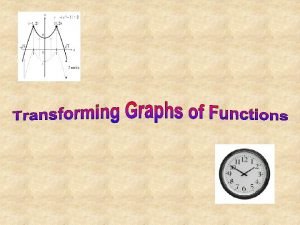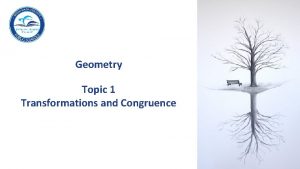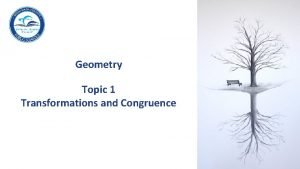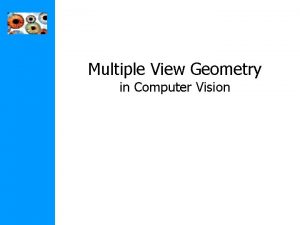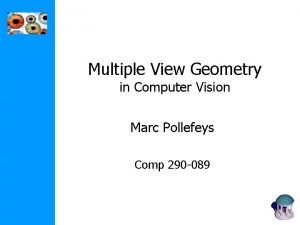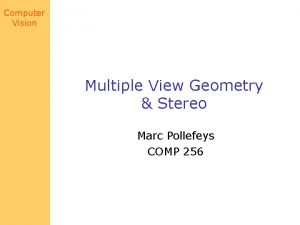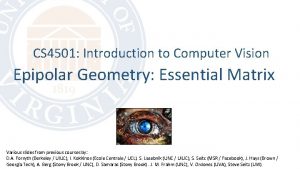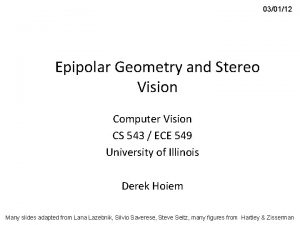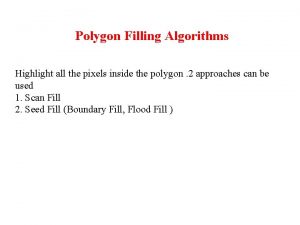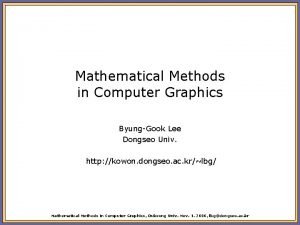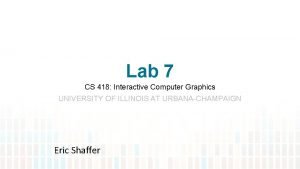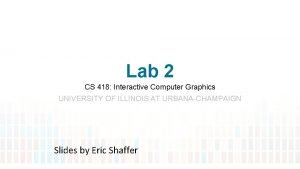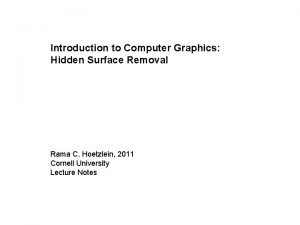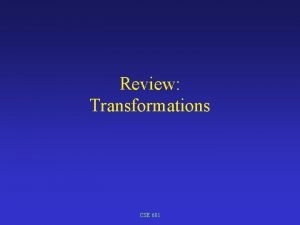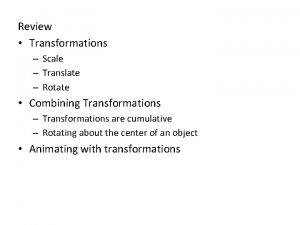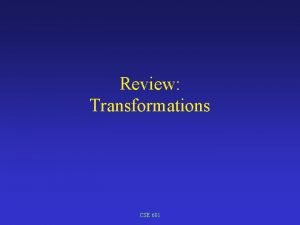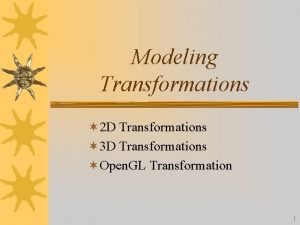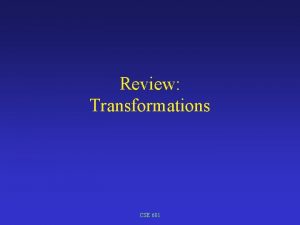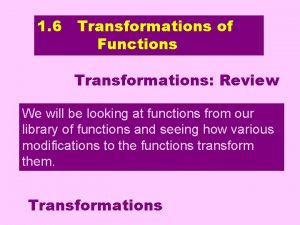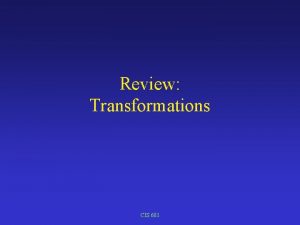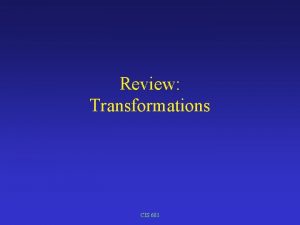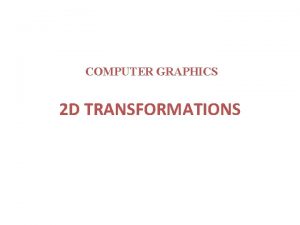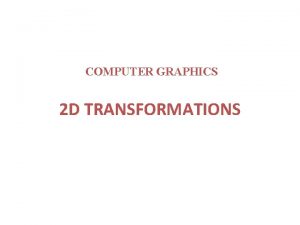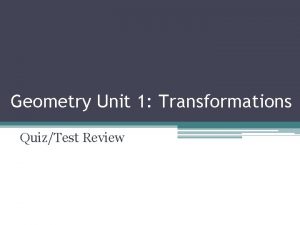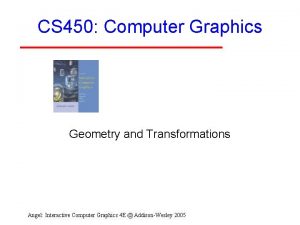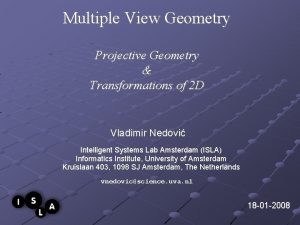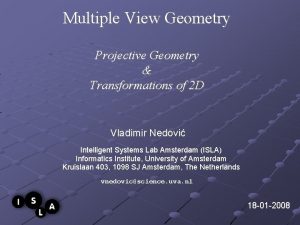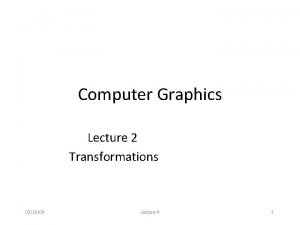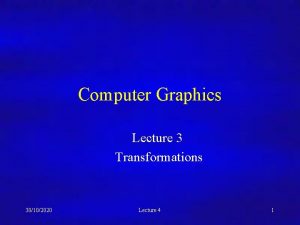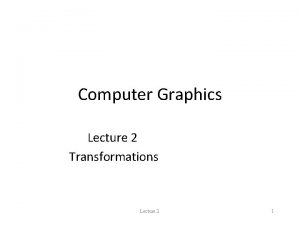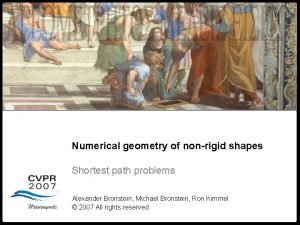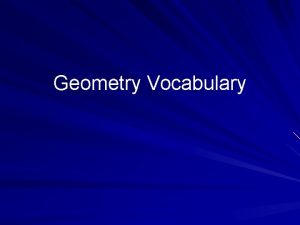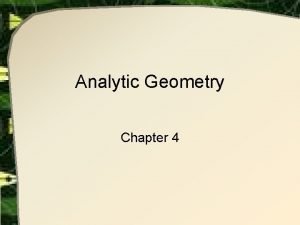Computer Graphics Lecture 4 Geometry Transformations Computer Graphics




































- Slides: 36

Computer Graphics Lecture 4 Geometry & Transformations

Computer Graphics Some Basics • Basic geometric types. – Scalars s – Vectors v – Points p = p + s * v • Transformations – Types of transformation: rotation, translation, scale. – Matrix representation – Order • Geometric modelling – Hierarchical modelling – Polyhedral shapes. 7/10/2008 Lecture 4 2

Computer Graphics Transformations. What is a transformation? • P =T(P) Why use them? • Modelling - Create objects in natural/convenient coordinates - Multiple instances of a prototype shape - Kinematics of linkages/skeletons - robot animation • Viewing – Windows and device independence – Virtual camera: parallel and perspective projections 7/10/2008 Lecture 4 3

Computer Graphics Types of Transformations Continuous (preserves neighbourhoods) One to one, invertible Classify by invariants or symmetries Isometry (distance preserved) – Reflections (interchanges left-handed and righthanded) – Rigid body motion: Rotations + Translations Similarity (preserves angles) – Uniform scale Affine (preserves parallel lines) – Non-uniform scales, shears or skews Collineation (lines remain lines) – Perspective Non-linear (lines become curves) – Twists, bends, warps, morphs, . . . 7/10/2008 Lecture 4 4

Computer Graphics 2 D Translations. P’ P 7/10/2008 Lecture 4 5

Computer Graphics 2 D Scaling from the origin. P’ P 7/10/2008 Lecture 4 6

Computer Graphics 2 D Rotation about the origin. y P’(x’, y’) P(x, y) r r x 7/10/2008 Lecture 4 7

Computer Graphics 2 D Rotation about the origin. y P’(x’, y’) P(x, y) r y r x x 7/10/2008 Lecture 4 8

Computer Graphics 2 D Rotation about the origin. y P’(x’, y’) P(x, y) r y r x x 7/10/2008 Lecture 4 9

Computer Graphics 2 D Rotation about the origin. Substituting for r : Gives us : 7/10/2008 Lecture 4 10

Computer Graphics 2 D Rotation about the origin. Rewriting in matrix form gives us : 7/10/2008 Lecture 4 11

Computer Graphics Transformations. • Translation. – P =T + P • Scale – P =S P • Rotation – P =R P • We would like all transformations to be multiplications so we can concatenate them • express points in homogenous coordinates. 7/10/2008 Lecture 4 12

Computer Graphics Homogeneous coordinates • Add an extra coordinate, W, to a point. – P(x, y, W). • Two sets of homogeneous coordinates represent the same point if they are a multiple of each other. – (2, 5, 3) and (4, 10, 6) represent the same point. • At least one component must be non-zero (0, 0, 0) is not defined. • If W 0 , divide by it to get Cartesian coordinates of point (x/W, y/W, 1). • If W=0, point is said to be at infinity. 7/10/2008 Lecture 4 13

Computer Graphics Homogeneous coordinates • If we represent (x, y, W) in 3 -space, all triples representing the same point describe a line passing through the origin. • If we homogenize the point, we get a point of form (x, y, 1) – homogenised points form a plane at W=1. W P W=1 plane X Y 7/10/2008 Lecture 4 14

Computer Graphics Translations in homogenised coordinates • Transformation matrices for 2 D translation are now 3 x 3. 7/10/2008 Lecture 4 15

Computer Graphics Concatenation. • We perform 2 translations on the same point: 7/10/2008 Lecture 4 16

Computer Graphics Concatenation. Matrix product is variously referred to as compounding, concatenation, or composition 7/10/2008 Lecture 4 17

Computer Graphics Concatenation. Matrix product is variously referred to as compounding, concatenation, or composition. This single matrix is called the Coordinate Transformation Matrix or CTM. 7/10/2008 Lecture 4 18

Computer Graphics Properties of translations. Note : 3. translation matrices are commutative. 7/10/2008 Lecture 4 19

Computer Graphics Homogeneous form of scale. Recall the (x, y) form of Scale : In homogeneous coordinates : 7/10/2008 Lecture 4 20

Computer Graphics Concatenation of scales. 7/10/2008 Lecture 4 21

Computer Graphics Homogeneous form of rotation. 7/10/2008 Lecture 4 22

Computer Graphics Orthogonality of rotation matrices. 7/10/2008 Lecture 4 23

Computer Graphics Other properties of rotation. 7/10/2008 Lecture 4 24

Computer Graphics Types of transformations. • Rotation and translation – Angles and distances are preserved – Unit cube is always unit cube – Rigid-Body transformations. • Rotation, translation and scale. – Angles & distances not preserved. – But parallel lines are. – Affine transformations. 7/10/2008 Lecture 4 25

Computer Graphics 3 D Transformations. • Use homogeneous coordinates, just as in 2 D case. • Transformations are now 4 x 4 matrices. • We will use a right-handed (world) coordinate system - ( z out of page ). y x Note: Convenient to think of display as Being left-handed !! ( z into the screen ) z (out of page) 7/10/2008 Lecture 4 26

Computer Graphics Translation in 3 D. Simple extension to the 3 D case: 7/10/2008 Lecture 4 27

Computer Graphics Scale in 3 D. Simple extension to the 3 D case: 7/10/2008 Lecture 4 28

Computer Graphics Rotation in 3 D • Need to specify which axis the rotation is about. • z-axis rotation is the same as the 2 D case. 7/10/2008 Lecture 4 29

Computer Graphics Rotation in 3 D • For rotation about the x and y axes: 7/10/2008 Lecture 4 30

Computer Graphics Rotation about an arbitrary axis? • • Hard! But we know how to rotate about the major axes. So turn required rotation into one about major axis. We need to translate arbitrary axis a to pass through origin, rotate to align with major axis, perform rotation, and rotate and translate back to original position. • Say Mz is the compound transformation to translate and rotate a to align with z-axis, then Mz-1 is the reverse transformation required to restore a to its original position. • Ignore translation for present, a passes through origin…. . 7/10/2008 Lecture 4 31

Computer Graphics How do we define M? M transforms a into a vector along the z-axis, ie. Ma = k Construct the rotation matrix R(a) as follows: Ra (a) = M-1 Rz(a)M A suitable M-1 can be found with a little effort, ie. M-1 k = a First define axis direction a as a unit vector as: a = (a 1, a 2, a 3) = Rz(- )Rx(- )k = (sin , sin cos , cos ) Thus: 7/10/2008 and: Lecture 4 32

Computer Graphics Rotation about arbitrary axis So: M-1 = Rz(- )Rx(- ) and therefore: M = Rx( )Rz( ) And the full expression for a rotation about an arbitrary axis is: Ra(a) = T-1 Rz(- )Rx(- )Rz(a)Rx( )Rz( )T Example: consider axis through origin, Thus = 45 o and = 0 o and Ra(a) = Rx(-45 o)Rz(a)Rx(45 o) 7/10/2008 Lecture 4 33

Computer Graphics Transformations of coordinate systems. • Have been discussing transformations as transforming points. • Useful to think of them as a change in coordinate system. • Model objects in a local coordinate system, and transform into the world system. • Unrealistic to think all objects are defined in the same coordinate system. 7/10/2008 Lecture 4 34

Computer Graphics Transformations of coordinate systems. 7/10/2008 Lecture 4 35

Computer Graphics Transform Left-Right, Right-Left Transforms between world coordinates and viewing coordinates. That is: between a right-handed set and a lefthanded set. 7/10/2008 Lecture 4 36
 Geometry in computer graphics
Geometry in computer graphics Multiple transformations geometry
Multiple transformations geometry Transformations and congruence
Transformations and congruence Congruent segments
Congruent segments Graphics monitors and workstations in computer graphics
Graphics monitors and workstations in computer graphics Introduction to computer graphics - ppt
Introduction to computer graphics - ppt 01:640:244 lecture notes - lecture 15: plat, idah, farad
01:640:244 lecture notes - lecture 15: plat, idah, farad Lewis structures and molecular geometry
Lewis structures and molecular geometry 4 electron domains 2 lone pairs
4 electron domains 2 lone pairs The basis of the vsepr model of molecular bonding is
The basis of the vsepr model of molecular bonding is Computer security 161 cryptocurrency lecture
Computer security 161 cryptocurrency lecture Computer aided drug design lecture notes
Computer aided drug design lecture notes Computer architecture notes
Computer architecture notes Microarchitecture vs isa
Microarchitecture vs isa Multiple view geometry in computer vision pdf
Multiple view geometry in computer vision pdf Multiple view geometry in computer vision
Multiple view geometry in computer vision Multiple view geometry in computer vision solution manual
Multiple view geometry in computer vision solution manual Epipolar geometry computer vision
Epipolar geometry computer vision Epipolar geometry computer vision
Epipolar geometry computer vision Crt in computer graphics
Crt in computer graphics Define projection in computer graphics
Define projection in computer graphics Plasma panel in computer graphics
Plasma panel in computer graphics Exterior clipping
Exterior clipping Shear transformation in computer graphics
Shear transformation in computer graphics Glsl asin
Glsl asin Scan conversation
Scan conversation Rigid body transformation in computer graphics
Rigid body transformation in computer graphics What are two different region filling algorithms
What are two different region filling algorithms Dda algorithm advantages and disadvantages
Dda algorithm advantages and disadvantages Polygon filling algorithms
Polygon filling algorithms Disadvantages of raster scan display
Disadvantages of raster scan display Computer graphics
Computer graphics Bresenham line drawing algorithm example
Bresenham line drawing algorithm example Cs 418
Cs 418 Glcreatebuffer
Glcreatebuffer Hidden surface removal in computer graphics
Hidden surface removal in computer graphics Achromatic light in computer graphics
Achromatic light in computer graphics

